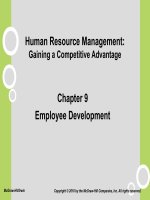Human resource management gaining a competitive advantage 2014 chapter 14
Bạn đang xem bản rút gọn của tài liệu. Xem và tải ngay bản đầy đủ của tài liệu tại đây (287.01 KB, 23 trang )
The Labor Relations Framework
Competitive
Challenges
- Legal
- Stakeholder needs
- High-performance
work systems
Goals
- Employees and unions
- Management
- Society
Union Structure and
Administration
Union Membership
and Relative
Bargaining Power
Union and Management
Interactions
- Organizing
- Negotiating
- Administering
Goal Attainment
- Employees and unions
- Management
- Society
14-1
Goals and Strategies
• Society
– Labor unions' major benefit to society throughout
history has been the balancing of power and the
institutionalization of industrial conflict in the least
costly way.
– The National Labor Relations Act (NLRA, 1935)
sought to provide a legal framework conducive to
collective bargaining.
• Management
– Must decide whether to encourage or discourage
the unionization of its employees.
• Labor Unions
– Seek to give workers formal representation in
setting the terms and conditions of employment.
14-2
Union Structure, Administration,
and Membership
• National and International Unions
– Craft unions
– Industrial unions
• Local Unions
– Responsible for the negotiations of a contract as
well as the day-to-day administration of the
contract, including the grievance procedure.
• AFL-CIO
– Not a union but rather an association that seeks
to advance the shared interest of its member
unions at the national level.
14-3
Union Security
Checkoff
Provision
Right-toWork Laws
Closed
Shop
Maintenance
of Membership
Union
Shop
Agency
Shop
14-4
Union Membership and
Bargaining Power
• Reasons for the consistent decline of
union membership in the U.S. include:
–
–
–
–
–
–
Structural Changes in the Economy
Increased Employer Resistance
Substitution with HRM
Substitution by Government Regulation
Worker Views
Union Actions
14-5
Legal Framework
• The 1935 NLRA enshrined collective
bargaining as the preferred mechanism
for settling labor-management disputes.
• Section 7 of the NLRA: employees have
the "right to self-organization, to form,
join, or assist labor organizations, to
bargain collectively through
representatives of their own choosing,
and to engage in other concerted
activities for the purpose of collective
bargaining."
14-6
Unfair Labor Practices (ULPs)
• The NLRA prohibits certain activities by both
employers and labor unions:
– Employers cannot interfere with, restrain, or
coerce employees in exercising their Section 7
rights.
– Employers cannot dominate or interfere with a
union.
– Employers may not discriminate against an
individual for exercising his or her right to join or
assist a union.
– Employers may not discriminate against
employees for providing testimony relevant to
enforcement of the NLRA.
– Employers cannot refuse to bargain collectively
with a certified union.
14-7
Unfair Labor Practices - Unions
• Originally the NLRA did not list
any union unfair labor
practices. These were added
by the 1947 Taft-Hartley Act.
• The 1959 Landrum-Griffin Act
further regulated unions’
actions and their internal
affairs
– i.e. financial disclosure and
conduct of elections.
14-8
Enforcement
• The National Labor Relations Board
(NLRB) has the primary responsibility for
enforcing the NLRA.
– The NLRB is a five-member board appointed
by the president. Additionally, there are 33
regional offices.
– The NLRB has two major functions:
• To conduct and certify representation elections.
• To prevent unfair labor practices.
– ULP charges are filed at and investigated by
the regional offices.
14-9
Why Do Employees Join
Unions?
• Virtually every decision to join a
union focuses on two questions?
– Is there a gap between pay, benefits,
and other conditions of employment
that employees actually receive
versus what they believe they should
receive?
– If such a gap exists, is it sufficiently
large enough to motivate employees
to remedy the situation?
14-10
The Process and Legal
Framework of Organizing
• An election may be held if at least 30 percent of
the employees in the bargaining unit sign
authorization cards.
• A secret ballot election will be held. The union is
certified by the NLRB if a simple majority of
employees vote for it.
• A decertification election may be held if no other
election has been held within the year or if no
contract is in force.
• Certain categories of employees cannot be
included in bargaining units.
14-11
Organizing Campaigns
• The NLRB may set aside the results of an
election if the employer has created an
atmosphere of confusion or fear of reprisals.
• Associate union membership is a form of
union membership in which the union receives
dues in exchange for services but does not
provide representation in collective bargaining.
• Corporate campaigns seek to bring public,
financial, or political pressure on employers
during the organizing and negotiating process.
14-12
The Negotiation Process
Distributive
Bargaining
- win/lose
Intraorganizational
Bargaining
- conflicting objectives of
different factions
Integrative
Bargaining
- win/win
Attitudinal
Structuring
- relationship
and trust
14-13
Preparing Managers for
Negotiations
• Seven steps:
– Establish interdepartmental contract
objectives.
– Review the old contract.
– Prepare and analyze data.
– Anticipate union demands.
– Establish the costs of various possible
contract provisions.
– Make preparations for a strike.
– Determine the strategy and logistics.
14-14
Negotiation Stages and Tactics
• The early stages may include many
individuals, as union proposals are
presented.
• During the middle stages, each side
makes decisions regarding priorities,
theirs and the other parties'.
• In the final stage, momentum may build
toward settlement or pressure may build
as an impasse becomes more apparent.
May involve interaction with negotiators
or facilitators.
14-15
Management’s Willingness to
Take a Strike
• The following factors help determine
whether management is able to take a
strike:
–
–
–
–
–
Product Demand
Product Perishability
Technology
Availability of Replacement Workers
Multiple Production Sites and Staggered
Contracts
– Integrated Facilities
– Lack of Substitutes for the Product
14-16
Alternatives to Strikes
• Mediation - Has no formal
authority to force a solution;
acts as a facilitator for the
parties.
• Fact finder - Investigates and
reports on the reasons for the
dispute and both sides'
positions.
• Arbitration - A process through
which a neutral party makes a
final and binding decision.
14-17
Grievance Procedure
• The negotiation process typically occurs every
three years.
• Negotiation processes and administration
processes are linked.
• The effectiveness of grievance procedures may
be judged on three criteria:
– How well are day-to-day problems resolved?
– How well does the process adjust to changing
circumstances?
– In multi-unit contracts, how well does the process
handle local contract issues?
• Duty of fair representation
14-18
Grievance Procedure
• Arbitration is a final and binding step.
• Criteria arbitrators use to reach decisions
include:
– Did the employee know the rule and the
consequences of violating it?
– Was the rule applied in a consistent and
predictable way?
– Were the facts collected in a fair and
systematic way?
– Did the employee have the right to question
the facts and present a defense?
– Does the employee have the right of appeal?
– Is there progressive discipline?
– Are there mitigating circumstances?
14-19
New Labor Management
Strategies
• There are signs of a transformation
from an adversarial approach to a less
adversarial and more constructive
approach to union-management
relations.
– The transformation includes
increasing worker involvement and
participation and reorganizing work
to increase flexibility.
• Union leaders have frequently
resisted such change, fearing an
erosion of their influence.
14-20
Labor Relations Outcomes
• Strikes
• Wages and Benefits
– In 2006, private-sector unionized workers received, on
average, wages that were 24 percent higher than
nonunion counterparts.
• Productivity
– Some argue that unions increase productivity, while
other argue that they decrease productivity.
– Studies have concluded that union workers are more
productive than nonunion workers although the
explanation is unclear.
• Profits and Stock Performance
– These may suffer under unionization if costs are raised.
14-21
The International Context
• The United States has both the largest
number of union members and the
lowest unionization rate of any
Western European country or Japan.
• The growing globalization of markets
will continue to put pressure on labor
costs and productivity.
• The United States differs from Western
Europe in the degree of formal worker
participation in decision-making.
14-22
The Public Sector
• During the 1960s and 1970s,
unionization in the public sector
increased dramatically.
• As of 2006, 36 percent of government
employees were covered by a union
contract, and 42 percent of all
government employees were covered by
a collective bargaining contract.
• Strikes are illegal at the federal level and
in many states for government workers.
14-23









